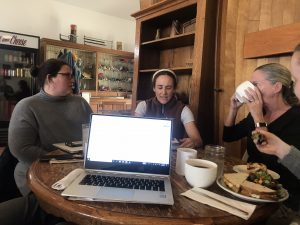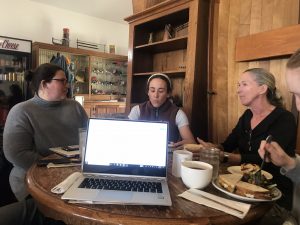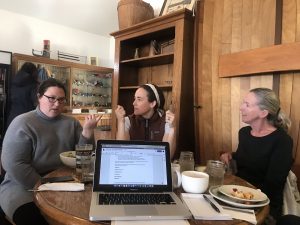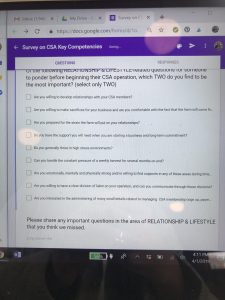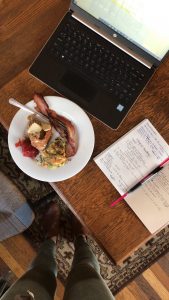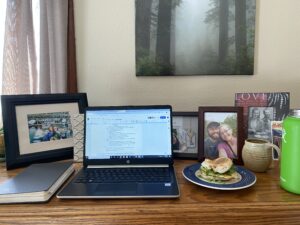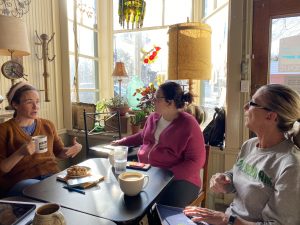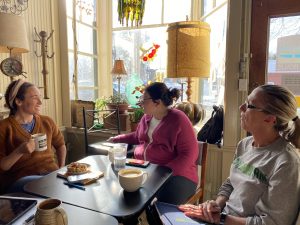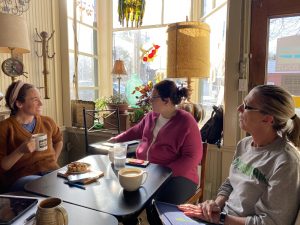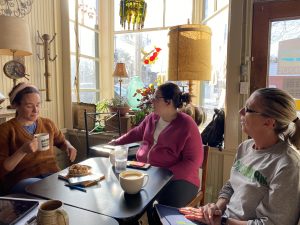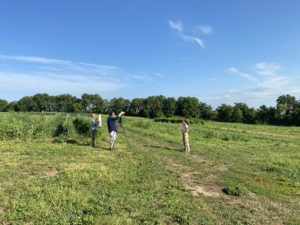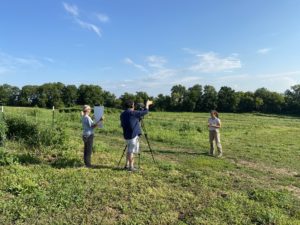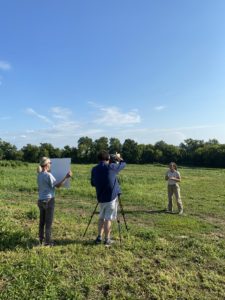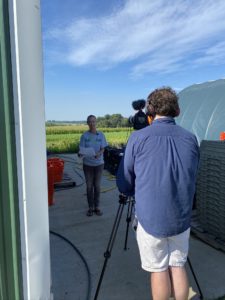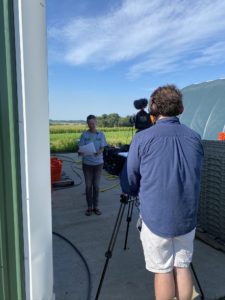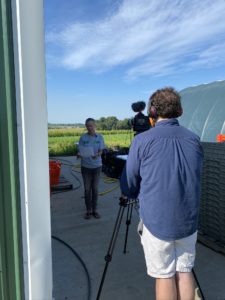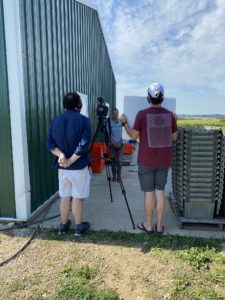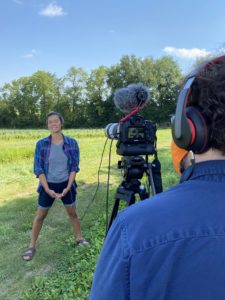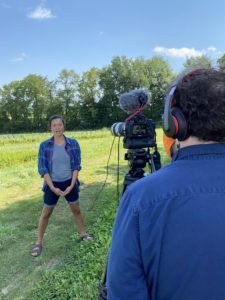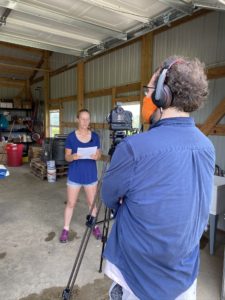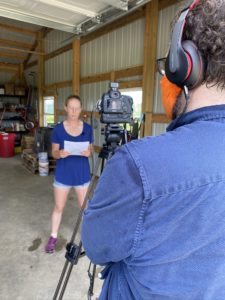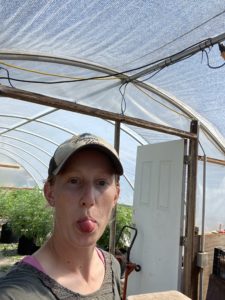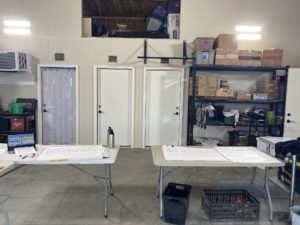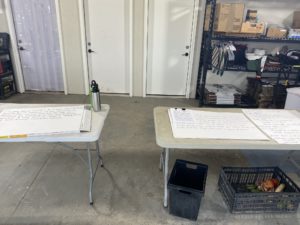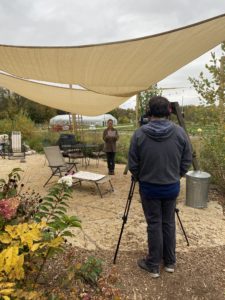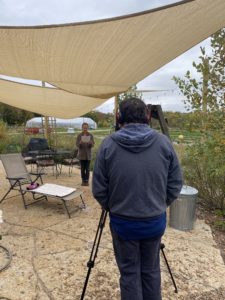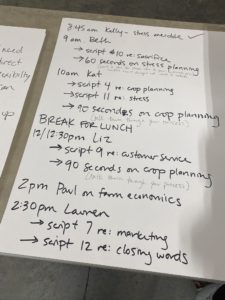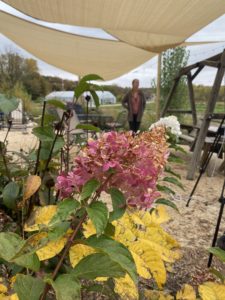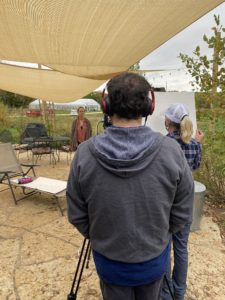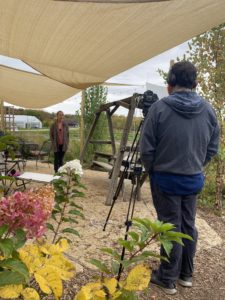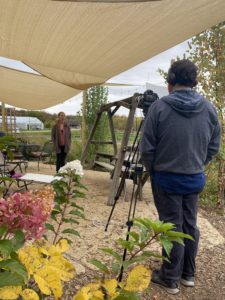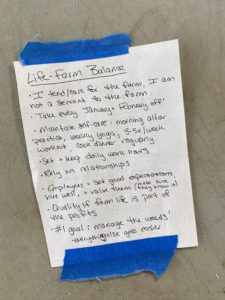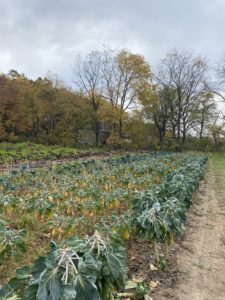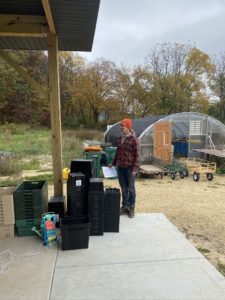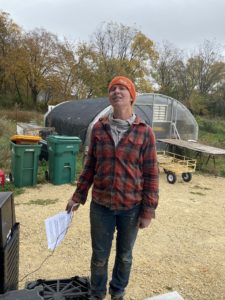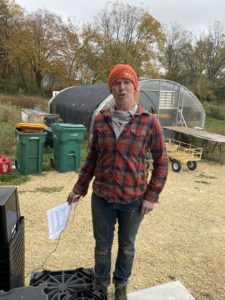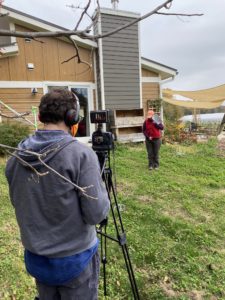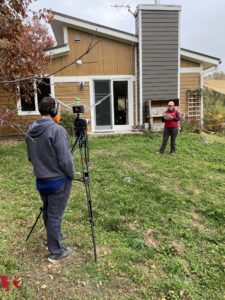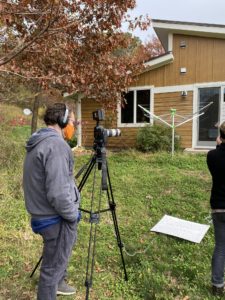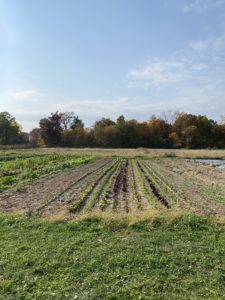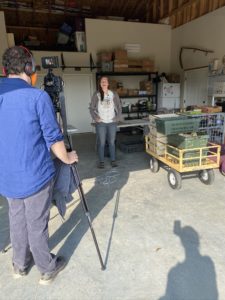Final report for FNC19-1190
Project Information
I own and operate Raleigh's Hillside Farm, LLC with my husband, Kyle, south of Evansville, Wisconsin. We lease ten acres from my parents and have approximately five acres in production in certified organic produce and hemp. The majority (about 80%) of our produce is distributed through a 400-member CSA. We have done CSA since our farm began in 2013 and have been growing it ever since. We have always been focused on experimenting with sustainability practices for our land, our finances and our lifestyle priorities to varied success.
Community Supported Agriculture (CSA) farmers around the country have observed declining rates of enrollment. Not only are retention rates generally low, CSA participation overall seems to be declining. Founded in the 1980’s, CSA grew slowly until 2010 when the rapid expansion and overuse of the CSA business model (often without true understanding of the concept) led to the current degradation of the movement.
This project aims to reduce the problem of individual farm failure within the CSA model in order to strengthen CSA more broadly. Through a 12-part video series, beginning and aspiring farmers will be asked to evaluate whether or not CSA is an appropriate business model for them to pursue. Upon viewing this video series, some farmers will move forward with CSA having gained the knowledge to be successful. With increased knowledge of expectations inherent in CSA, these farmers will be more likely to retain members, complete their season and be financially viable in the long-term. Other farmers who view the series will determine the model is not an appropriate fit and position themselves to market their products through different avenues. Both outcomes will maintain, expand and enhance CSA markets in the long-term.
Since being released in July of 2021, this project has been tremendously well-received across the CSA space. Many CSA experts in our region have shared that it fits a necessary gap in education currently available to farmers. The CSA model continues to increase in popularity among farmers and many are hoping to learn more about what this model entails and if it would be a good fit for their business. Since release (a little over a month ago), 62 people have watched the first video that introduces the series and most other videos have received 30-50 views to date with new views every single day!
One farmer who viewed the whole series shared, "I watched the whole series and found it very informative. The videos were beautifully produced, and loaded with useful information." Another farmer with moderate experience with CSA shared that our series "did an excellent job of covering the pitfalls"-- a major goal of the project. This same farmer shared that she planned to use the information learned in this video in the next 6 months. Specifically, she will outsource some of the financial work of her business to a financial professional. All in all, feedback has been favorable and we are thrilled to have created a free resource like this for farmers. We cannot wait to see the viewership grow over the next several months and read the feedback other farmers have for us as we dream up new projects.
- Work with CSA farmers around the Midwest to refine 10 questions aspiring or beginner CSA farmers should ask themselves before getting started.
- Develop a curriculum, script and materials for twelve videos with a small group of farmers surrounding these 10 questions.
- Collaborate with filmmaker to create twelve 10-minute videos to be uploaded onto YouTube for free access to farmers nationally.
- Disseminate and promote videos through social media, relevant networks and listservs for viewership by at least 100 farmers.
- Collect survey results from video viewers to measure knowledge gained as well as benefits and impacts to long-term farming success.
Cooperators
- - Producer
- - Producer
- - Producer
- - Producer
- - Producer
Research
This educational project features a 12-part online video series that will be posted to YouTube and shared through web-based networks, social media, and partners at no cost. Series content is inspired by a 90-minute workshop presented on a similar topic at the 2017 Wisconsin Farmers’ Union biannual CSA conference. The presentation was well-received but the volume of information was difficult to assimilate in the short timeframe. Additionally, the time allotment limited thorough instruction into more complex subjects.
By breaking the content into an introduction, exploration of ten individual assessment questions, and a conclusion, this video series can be digested in a way that works well for each individual viewer. It will also be available to experienced farmers who may not need (or want) to sit through a two-hour presentation on CSA, but seek knowledge on individual topics. A video series has the added benefit of being readily available online, allowing farmers the flexibility to view it on their personal schedule. Travel to conferences can be expensive and unintentionally exclusive; a video series requires only an internet-connected device making the service inclusive to all income levels and backgrounds. Recognizing limited broadband access in some rural areas, thumb drives or DVDs will be available upon request. At the time of final grant reporting, no one had requested these materials.
Each video will present one cohesive topic through a combination of videos, quotes, photographs, data, and templates with voiceover instruction. Series content and curriculum will incorporate input from project collaborators and utilize two separate methods to engage additional experienced CSA farmers. Downloadable PDF worksheets will be provided for content reinforcement and note-taking. Hiring a qualified filmmaker to seamlessly integrate a wide-range of interviews and content will produce a professional-quality product to increase overall viewership levels.
Survey results attached. These survey results led us to the following ten questions for our video series:
- Are you passionate about the CSA model and movement?
- Do you already have solid production skills in agriculture, experience on another farm, or are you willing to develop relationships with consultants and mentors from the beginning to help you obtain the skills you need quickly?
- Are you interested in creating dynamic crop plans with many moving parts and do you have the skills and systems in place to plant in multiple successions per season?
- In addition to farming, are you committed to administering the many small details related to managing your CSA membership?
- Do you have a balanced approach to both short-term and long-term financial planning to support your other social and ecological goals?
- Do you understand your farm's unique identity and are you comfortable marketing your farm in your community?
- Are you willing to communicate with your members throughout the season in a consistent and organized fashion?
- Are you committed to doing ongoing customer service and education as part of your weekly work for much of the year?
- Are you willing to make sacrifices for your business and are you comfortable with the fact that the farm will come first several months out of the year?
- Do you have a plan for managing stress throughout the season and dealing with the constant pressure of a weekly harvest for several months on end?
Educational & Outreach Activities
Participation Summary:
Beginning April, 2019, the project team worked to create a comprehensive survey to determine this educational video series’ key questions. Distributed to over 100 CSA farmers with the help of various organizations (see attached), 64 respondents provided critical insight. Utilizing survey results, the project team has constructed a cohesive outline based on ten key questions that will comprise the video series, in addition to an introduction and conclusion.
The grant also was featured in a news article in the Janesville Gazette at this time. That can seen here.
|
Survey distribution list: |
How access? |
|
FairShare ListServ |
Email to: [email protected] |
|
FairShare national CSA partners |
Requested Carrie send it out |
|
MOSES Organic |
Email with request to share to: [email protected] |
|
Iowa Organic Farming Conference |
Email with request to share to: [email protected] |
|
Land Stewardship Project |
Email with request to share with CSA mailing list to: [email protected] |
|
Angelic Organics |
Email with request to share to: [email protected] |
|
Band of Farmers |
Email with request to share to: |
|
REAP |
Emailed both Helen and Alyssa with a request to share |
|
Illinois Stewardship Alliance-- Buy Fresh Buy Local |
Email with request to share to: [email protected] |
|
Angie Sullivan (DATCP) |
|
|
Nature’s International newsletter |
Submitted website contact form with request to share in upcoming newsletter |
|
MOSA newsletter |
Email with request to share in upcoming newsletter to: Joe Pedretti <[email protected]> |
|
Veggie Producers conference list |
Email to Claire with request to share |
|
Sarah Llyod-- WFU newsletter |
Emails to Sarah Lloyd and Danielle Endvick with request to feature in upcoming newsletter |
|
Southern State SSWAG |
Email with request to share in an upcoming newsletter to: [email protected] |
|
High Mowing Seeds |
Paul Betz email with request to share in an upcoming email newsletter |
|
CSA Facebook group & Marketing Facebook group |
|
|
Michelle Wyler (CSA innovation network) |
In the spring of 2020, our team moved towards video production. This was a very intensive part of the project requiring much more time to draft, review, and edit the video scripts than initially proposed. Using the key themes identified by our CSA survey, our farmer group defined the topic of each video and then the course objectives.
From there, Lauren, Beth and Kelly worked on creating video script drafts and sharing them with the full farmer team as they were finalized. Edits were made as needed. Final scripts were also shared with the filmmaker through monthly meetings to ensure the project was meeting its desired objectives and moving us towards an efficient film shoot day. Further edits were made as needed.
In August 2020, we began filming at Raleigh's Hillside Farm. The scripts from six films were put onto note sheets and cue cards, and our team spent a day at the farm recording the bulk of these six videos as well as B-roll footage. (B-roll footage is additional video footage -- such as farm scenes -- shot to help illustrate the main footage, which in this case was the interviews). In October 2020, this process was repeated at Winterfell Acres with the remaining six films and scripts. Throughout the late summer and fall, Lauren also coordinated collection of additional B-roll footage with the filmmaker at various CSA locations.
Winter was spent working with the filmmaker to collect and record key stories and techniques from various farmers across the region over Zoom. Once these pieces were finalized, the filmmaker began full production of each of the twelve videos weaving together footage from our farm film days with the stories collected over Zoom along with B-roll and other imagery to strengthen the films. These first drafts of the films began being distributed in early February and the focus of the next 2-3 months is on finalizing them so they are ready for release and distribution through the CSA Innovation Network by late spring/early summer.
The videos went live on the CSA Innovation Network website on July 12th, 2021. These videos can all be found here: https://www.csainnovationnetwork.org/csa-starts-here
The video series was promoted in various ways after going live:
- The video webpage and a summary of the final product was sent to all video participants as well as all organizations and individuals who had been notified of the initial project and survey.
- The resources were also shared on social media.
- The CSA Innovation Network sent a stand-alone email promoting the resource in late July to their email list of 3000 people. We will also be hosting a webinar with the CSA Innovation Network in the fall of 2021 to promote the series at a time when farmers are more available to view it and not so busy with their farming seasons. This will include several emails to their email list promoting both the webinar and the video series.
- A podcast detailing the project was shared via the My Digital Farmer podcast on August 11, 2021. The link to this podcast can be found here: https://mydigitalfarmer.com/120-2/ To date, 579 have listened to this episode.
- The CSA Innovation Network began a social media advertising campaign on behalf of this grant project on August 23, 2021. It is set to run through the end of November 2021.
- Lauren is also scheduled to be part of a webinar on September 2nd with Corinna Bench and Local Line representative Katrina where she will be able to speak about CSA and this resource specifically. The topic of the webinar is helping interested farmers determine if CSA is a good fit. The webinar is being offered to an email list of 15,000 farmers. The recording of the webinar will also be shared with this list of farmers. There's no link online for the event but you can find the link to sign up here.
An updated timeline of grant and photos of work throughout project are attached.
SARE budget & timeline tracking - Timeline
April 2019 meeting & follow up:
December 2019 meeting & follow up:
January 2020 phone meeting:
February 2020 meeting:
August 2020 film day:
October 2020 film day:
Learning Outcomes
Several lessons were learned by our farm cohort in the creation of this video series. First, we learned that CSA farmers really care about and love CSA as a business model. Support and interest in this project was widespread, especially in the Midwest region. Collaboration was easy and involvement was wide-spread in this first phase. CSA survey results attached. Survey results
We've also learned how variable best practice is within various elements of CSA across the region and country which led to our incorporation of many more voices and narratives than the 16 we originally wrote into the grant. We are in touch with 20+ farms for their participation and storytelling within the series. Some of these great examples and best practices have already affected how I communicate with our CSA members throughout the CSA season and think about managing stress while farming.
The most unexpected thing learned through development of the series was the deep need for farmer support networks beyond conference season. Stress, stress management, work life balance and understanding the sacrifices you were making for your business came up often and it was easy for farmer team meetings to turn towards identifying strategies together. Future work will likely move more deeply into this realm.
Additional findings during this grant from the farmers who created the project were largely based on the format. Ultimately we learned that film may not be the best medium for this type of educational product. It is very time intensive, requires farmers to come in person on filming days (for best quality), and is also fairly expensive.
A webinar series or online course format may have been easier and cheaper to produce. Weaving together various stories and pieces of education through film is a very long process with more time spent upfront on script production and at the end on editing than originally thought. The fact that a webinar or online course style of content could be filmed at home using our own devices and then edited together to create a similar product in the end could create a much more affordable and quicker to produce product (which is good as some content with CSA evolves quickly over time and needs updating frequently). Some education would be lost without B-roll scenes from CSA farms (a definite advantage of film) but perhaps that could be worked in some other ways.
Because the video series was only published six weeks before the time of submitting this report, we are still evaluating how the series is effecting farmers knowledge, attitude, skills and awareness on a larger scale, but we will assess this over time. An evaluation strategy was built into the video dissemination process to track viewership and changes in KASA (Knowledge, Attitudes, Skills, Awareness) as a result of the project. We used two strategies to track the reach of the videos. The first is simply tracking YouTube views. The second includes implementing Bit.ly shortlinks for each video, which allows us to track how many people clicked to access the video from the CSA Starts Here webpage.
In addition, we implemented evaluation strategies to track the demographic information and contact information of video viewers to learn about the viewing audience and collect contact information for follow up and post-video evaluation. Upon clicking on the link to view each video from the webpage, viewers were connected to a brief form requesting basic demographic and contact information for later evaluation. Upon completing the survey they were automatically directed to the video. The table below summarizes the number of completed pre-surveys for each video, totalling 215. A summary of viewers’ beginning farmer status is below in the purple columns. More than half of the viewers for 8 of the 12 videos were were classified as beginning farmers.
To assess viewer changes in KASA, a brief evaluation survey was created for viewers to complete after each video. The evaluation request and survey link for viewers is included when viewers access the videos, is in the YouTube description for each video, and mentioned in the end of each video. Even with the strategy, completion of the post-video evaluation survey by viewers was very low, with only one completed evaluation surveys out of 215. Within six weeks of watching the videos, an email was sent to all recorded viewers with a request to complete the evaluation survey, which generated only one new post-evaluation survey. Without these completed surveys, it is impossible to quantify viewer changes in KASA from the video, but it’s not for a lack of trying. A general follow-up evaluation survey is created and will be sent to viewers three months after they watch a video to collect longer term impacts and remaining questions.
Table 1: Video evaluation data
|
Video |
YouTube Views |
Completed Pre-Video Surveys |
# Beginning Farmer |
% Beginning Farmer |
Completed Post-Video Eval Surveys |
Lauren Newsletter Subscribers |
FairShare Newsletter Subscribers |
|
#1 |
88 |
57 |
39 |
68% |
1 |
45 |
52 |
|
#2 |
64 |
31 |
19 |
61% |
0 |
18 |
22 |
|
#3 |
52 |
22 |
15 |
68% |
0 |
11 |
14 |
|
#4 |
52 |
21 |
16 |
76% |
0 |
14 |
16 |
|
#5 |
33 |
19 |
9 |
47% |
0 |
12 |
14 |
|
#6 |
35 |
16 |
9 |
56% |
0 |
7 |
9 |
|
#7 |
30 |
12 |
5 |
42% |
0 |
6 |
9 |
|
#8 |
25 |
10 |
5 |
50% |
0 |
5 |
7 |
|
#9 |
24 |
7 |
3 |
43% |
0 |
3 |
6 |
|
#10 |
22 |
7 |
4 |
57% |
0 |
4 |
5 |
|
#11 |
35 |
9 |
4 |
44% |
0 |
4 |
6 |
|
#12 |
25 |
4 |
4 |
100% |
1 |
1 |
2 |
|
485 |
215 |
132 |
2 |
130 |
162 |
Project Outcomes
Creation of stress work plans
Farmer support groups for creating and discussing stress management
